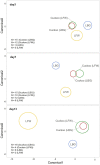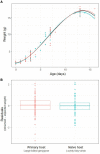Imperfect mimicry of host begging calls by a brood parasitic cuckoo: a cue for nestling rejection by hosts?
- PMID: 34805544
- PMCID: PMC8599026
- DOI: 10.1093/cz/zoab056
Imperfect mimicry of host begging calls by a brood parasitic cuckoo: a cue for nestling rejection by hosts?
Abstract
Coevolutionary interactions between avian brood parasites and their hosts often lead to the evolution of discrimination and rejection of parasite eggs or chicks by hosts based on visual cues, and the evolution of visual mimicry of host eggs or chicks by brood parasites. Hosts may also base rejection of brood parasite nestlings on vocal cues, which would in turn select for mimicry of host begging calls in brood parasite chicks. In cuckoos that exploit multiple hosts with different begging calls, call structure may be plastic, allowing nestlings to modify their calls to match those of their various hosts, or fixed, in which case we would predict either imperfect mimicry or divergence of the species into host-specific lineages. In our study of the little bronze-cuckoo (LBC) Chalcites minutillus and its primary host, the large-billed gerygone Gerygone magnirostris, we tested whether: (1) hosts use nestling vocalizations as a cue to discriminate cuckoo chicks; (2) cuckoo nestlings mimic the host begging calls throughout the nestling period; and (3) the cuckoo begging calls are plastic, thereby facilitating mimicry of the calls of different hosts. We found that the begging calls of LBCs are most similar to their gerygone hosts shortly after hatching (when rejection by hosts typically occurs) but become less similar as cuckoo chicks get older. Begging call structure may be used as a cue for rejection by hosts, and these results are consistent with gerygone defenses selecting for age-specific vocal mimicry in cuckoo chicks. We found no evidence that LBC begging calls were plastic.
Keywords: begging call; bronze-cuckoo; brood parasitism; coevolution; gerygone.
© The Author(s) (2021). Published by Oxford University Press on behalf of Editorial Office, Current Zoology.
Figures







Similar articles
-
Discrimination and ejection of eggs and nestlings by the fan-tailed gerygone from New Caledonia.Curr Zool. 2021 Aug 13;67(6):653-663. doi: 10.1093/cz/zoab066. eCollection 2021 Dec. Curr Zool. 2021. PMID: 34805543 Free PMC article.
-
True recognition of nestlings by hosts selects for mimetic cuckoo chicks.Proc Biol Sci. 2018 Jun 13;285(1880):20180726. doi: 10.1098/rspb.2018.0726. Proc Biol Sci. 2018. PMID: 29875305 Free PMC article.
-
Polymorphism at the nestling stage and host-specific mimicry in an Australasian cuckoo-host arms race.J Anim Ecol. 2023 Jan;92(1):30-43. doi: 10.1111/1365-2656.13849. Epub 2022 Dec 11. J Anim Ecol. 2023. PMID: 36426636 Review.
-
Visual mimicry of host nestlings by cuckoos.Proc Biol Sci. 2011 Aug 22;278(1717):2455-63. doi: 10.1098/rspb.2010.2391. Epub 2011 Jan 12. Proc Biol Sci. 2011. PMID: 21227972 Free PMC article.
-
The overlooked complexity of avian brood parasite-host relationships.Ecol Lett. 2022 Aug;25(8):1889-1904. doi: 10.1111/ele.14062. Epub 2022 Jun 28. Ecol Lett. 2022. PMID: 35763605 Free PMC article. Review.
Cited by
-
Personality, recognition cues, and nest sanitation in obligate avian brood parasitism: what do we know and what comes next?Curr Zool. 2021 Sep 20;67(6):621-623. doi: 10.1093/cz/zoab079. eCollection 2021 Dec. Curr Zool. 2021. PMID: 34805538 Free PMC article. No abstract available.
-
The past and future of mimicry research.Nat Ecol Evol. 2025 Jul;9(7):1081-1085. doi: 10.1038/s41559-025-02775-8. Nat Ecol Evol. 2025. PMID: 40588536 No abstract available.
References
-
- Anderson MG, Ross HA, Brunton DH, Hauber ME, 2009a. Begging call matching between a specialist brood parasite and its host: a comparative approach to detect coevolution. Biol J Linn Soc 98:208–216.
-
- Bates DMaechler M, 2009. Package “lme4”. http://cran. r-project.org/web/packages/lme4/lme4.pdf.
-
- Briskie JV, Martin PR, Martin TE, 1999. Nest predation and the evolution of nestling begging calls. Proc Royal Soc B 266:2153–2159.
LinkOut - more resources
Full Text Sources
Miscellaneous
